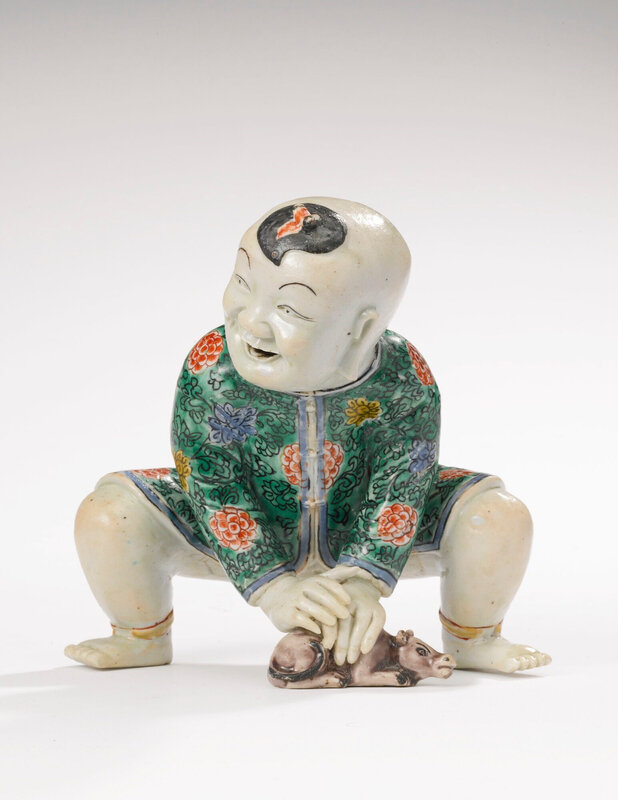A susancai figure of a young boy, Qing dynasty, Kangxi period (1662-1722)

A susancai figure of a young boy, Qing dynasty, Kangxi period (1662-1722). Height 5 1/2 in., 14 cm. Photo Sotheby's
Provenance: Priestley & Ferraro, London, 2005.
Note: This figure of a small boy has large implication. Customs and traditions centered around the birth of a son were serious business. The birth of a male heir meant someone who could bring honor to the family name and carry on the lineage. Not necessarily understanding their significance, these diminutive sculptures captivated Western collectiors with their playful charm. Two similar but seated figures are illustrated in Anthony du Boulay, Christie’s Pictorial History of Chinese Ceramics,Glasgow, 1984, p. 289, no. 11 where the author suggest that the pair appears in the 1688 inventory of Burghley House as ‘two laughing fryors” placing the form in the early part of the Kangxi period.
The present figure is modeled in a somewhat unusual pose, crouched forward, the hands atop the small figure of an ox or water buffalo. This may be an allusion to the ancient myth of the herd boy who falls in love with the star maiden or perhaps a reference to Daoism, as Laozi is frequently represented riding on a water buffalo. The representation of boys, carefree, laughing and seemingly at ‘play’ contains metaphorical references to the tools they will need to succeed both materially and spiritually in adult life.
Sotheby's. Embracing Classic Chinese Culture: Kangxi Porcelain from the Jie Rui Tang Collection, New York, 14 march 2014

/https%3A%2F%2Fprofilepics.canalblog.com%2Fprofilepics%2F1%2F0%2F100183.jpg)
/https%3A%2F%2Fstorage.canalblog.com%2F03%2F02%2F119589%2F96711876_o.jpg)
/https%3A%2F%2Fstorage.canalblog.com%2F11%2F31%2F119589%2F94773502_o.jpg)
/https%3A%2F%2Fstorage.canalblog.com%2F20%2F83%2F119589%2F94772815_o.jpg)
/https%3A%2F%2Fstorage.canalblog.com%2F26%2F72%2F119589%2F75604929_o.jpg)
/https%3A%2F%2Fstorage.canalblog.com%2F59%2F60%2F119589%2F26458628_o.jpg)


/http%3A%2F%2Fstorage.canalblog.com%2F76%2F61%2F119589%2F118867846_o.jpg)
/http%3A%2F%2Fstorage.canalblog.com%2F83%2F36%2F577050%2F39211685_p.jpg)
/http%3A%2F%2Fstorage.canalblog.com%2F71%2F91%2F119589%2F30056120_o.jpg)
/image%2F1371349%2F20240423%2Fob_af8bb4_telechargement-6.jpg)